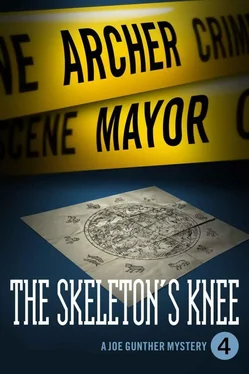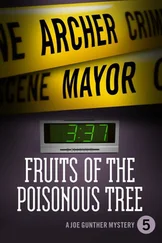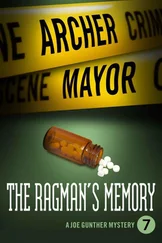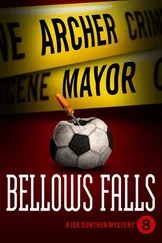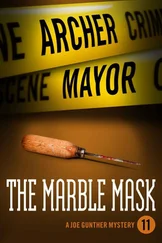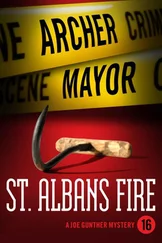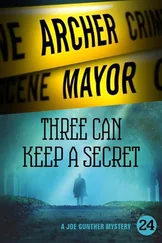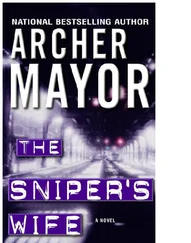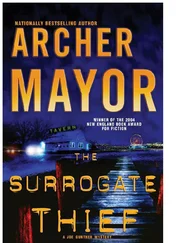Archer Mayor - The Skeleton's knee
Здесь есть возможность читать онлайн «Archer Mayor - The Skeleton's knee» весь текст электронной книги совершенно бесплатно (целиком полную версию без сокращений). В некоторых случаях можно слушать аудио, скачать через торрент в формате fb2 и присутствует краткое содержание. Год выпуска: 1993, ISBN: 1993, Издательство: MarchMedia, Жанр: Полицейский детектив, на английском языке. Описание произведения, (предисловие) а так же отзывы посетителей доступны на портале библиотеки ЛибКат.
- Название:The Skeleton's knee
- Автор:
- Издательство:MarchMedia
- Жанр:
- Год:1993
- ISBN:9781939767042
- Рейтинг книги:3 / 5. Голосов: 1
-
Избранное:Добавить в избранное
- Отзывы:
-
Ваша оценка:
- 60
- 1
- 2
- 3
- 4
- 5
The Skeleton's knee: краткое содержание, описание и аннотация
Предлагаем к чтению аннотацию, описание, краткое содержание или предисловие (зависит от того, что написал сам автор книги «The Skeleton's knee»). Если вы не нашли необходимую информацию о книге — напишите в комментариях, мы постараемся отыскать её.
The Skeleton's knee — читать онлайн бесплатно полную книгу (весь текст) целиком
Ниже представлен текст книги, разбитый по страницам. Система сохранения места последней прочитанной страницы, позволяет с удобством читать онлайн бесплатно книгу «The Skeleton's knee», без необходимости каждый раз заново искать на чём Вы остановились. Поставьте закладку, и сможете в любой момент перейти на страницу, на которой закончили чтение.
Интервал:
Закладка:
This place had none of that. It was as if the entire house had been plucked from a showroom and airlifted into the wilderness.
I stepped inside and closed the door behind me, acutely conscious of my intrusiveness. Shafts of sunlight angled in through the clear windows, reflecting off the pale, scrubbed wood floors and muted oval rag rugs. I took the first shot of a fresh roll of film.
The furniture was spare, old but not antique, solid and comfortable in appearance, obviously belonging to a determinedly single person: one armchair by the wood stove, one chair at the table, one set of eating utensils by the sink. More than the home of a man who lived alone, this was a monument to someone wishing absolute solitude.
As John Breen had described, the cabin consisted of one large room, where the kitchen occupied one end of a combination dining-living area. An overhead platform loft jutted out from one far wall, hovering between the floor where I stood and an overall cathedral ceiling of massive wooden roof beams. A ladder to the loft was attached to the wall and disappeared through a hole above.
The only jarring note to the sparse tidiness rested on the floor near the long harvest-style table. Again, giving substance to Breen’s testimony, I could see where Fuller had lain in his own filth for days, surrounded by a half-spilled bag of trail mix, some partially rotted fruit, and the wadded-up table runner that he had used to drag these items over to him. I could also see by the way it was disturbed that the soiled rug had been used as a blanket during the cold nights. Given the oddly impersonal feeling of this otherwise clean and comfortable home, the remains of Abraham Fuller’s agonizing ordeal packed the same emotional punch as a blood-soaked sheet in an aseptic, empty operating room.
I turned away from the spot. I wanted to find out about the man who had ended up on that rug, but to do so, I felt the need to conclude my examination of his house there, rather than begin it. I therefore started with the kitchen area, taking more pictures as I went.
Both Hillstrom and Brook had commented on Fuller’s diet. What I found, both in the cabinets and the electric refrigerator-an odd contrast to the hand pump by the sink-was an almost total absence of store-bought food. There were paper bags, glass containers, and tin boxes all carefully stored away by the dozen. None of them was labeled-another sure sign of single living-and all contained an assortment of mostly-to me-unrecognizable beans, flours, herbs, and liquids. For someone whose idea of heaven was boxed, neon-colored macaroni and cheese, I found Fuller’s cupboard about as appetizing as a bowlful of grass cuttings.
Nevertheless, I was impressed by the energy and specialized education it must have taken to fill all these shelves. It was, to my professional eye, a rarity, and any rarity in an investigation is also more easily traceable-or so I hoped.
My next stop was the loft, which turned out to be the bedroom. Again, I was struck by the monastic sparseness: a neat twin bed, a small chest of drawers half-filled with nondescript, sturdy clothes, and a simple night table with an electric lamp. The only window was mounted in the end wall, and the only place I could stand fully erect under the sloping roof beams was at the foot of the narrow bed, in the center of the platform. Looking over the balcony to the room below, the shafts of yellow sun highlighting the wool of the rugs and the grain of the wooden floor and furniture, I was briefly caught up by what must have made this place special to its occupant. There was a serenity to it, a hard-won peacefulness. This was a retreat more than a home, a shrine to what life could be away from the hubbub beyond the encircling trees.
I suddenly thought of another reason why such effort had been expended to keep this house so severely neat. It was a tribute to self discipline-a guide rule by which Fuller could measure his success at maintaining a straight and narrow line. In this light, the aesthetic serenity was not an end in itself, but a reward for personal sacrifice. Not for the first time, I wondered if Fuller might have isolated himself more for practical reasons and less for whimsical ones. Living here, he had only to look around every day to be reminded that being apart from the world was also being safe from the threats it might hold.
Not that I ruled out any whimsical motivations. To live in Brattleboro was to reside in one of the East’s more notable respites for aging hippies. I was very familiar with alternate lifestyles, and didn’t bat an eye at the usual naturalist trimmings, a good many of which were in evidence in this house. The difference in this case was the cash Fuller had on him, and the fact that it had appeared, bank-banded and moldy, out of a bag. That-and the bullet wound-introduced two distinctly foreign elements, and a suspicion that Fuller’s mania for neatness and isolation might be triggered by a self-preserving paranoia.
Downstairs, I’d noticed a wall full of books, but I hadn’t seen any photographs, address books, note pads, filing cabinets, or even a desk. There was nothing of a personal nature in the whole house, as far as I’d seen. It made me think of a recovering alcoholic not having booze in the house-because of the temptation it represented.
The one inconsistency with that observation hung over both the bed and the window behind it. It was a chart of some kind, framed and under glass. The chart was circular, its outer band divided into wedges like an old-time carnival money wheel, and parked within some of the wedges were odd symbols, like letters from an ancient foreign alphabet. The blank inner circle was crisscrossed by differently colored lines that connected the mysterious symbols in an overlapping series of triangles. To one side, apart from the circle, was another, much smaller chart, linear in form, with more enigmatic symbols and numbers.
I moved alongside the bed and leaned over to take a closer look. The entire document had been carefully handwritten, and it was not whole. One slightly fuzzy edge indicated that the paper, after much creasing, had been neatly torn across the top.
I hadn’t the slightest idea what this was, but I knew in my gut it was something personal to Abraham Fuller, which, in this barren context, made it-along with the obsessive vegetarianism-another rarity. Despite his obvious efforts to leave no trace of himself, I felt I was gaining, just a bit, on my quarry. I adjusted the camera to compensate for the light coming in through the window, then took several shots.
I returned downstairs to investigate the building’s two wings. The lean-to shed was accessible only from the outside, and it was filled with the expected accessories of a major-league organic gardener. In predictably neat rows and piles, I found a specialist’s paradise in tools, seeds, and natural fertilizers. Hanging in tidy bundles from the low rafters were mysterious bunches of bulbs, twigs, and dried leaves, all of which might have made sense to my long-dead father, who’d been a farmer, but not to me.
The other wing, the greenhouse, was connected by an inner door to the kitchen area. It was much larger than I’d thought from the outside, wider than the house, and half-buried in the ground, so that I had to climb down a short flight of steps to reach the wood-slatted floor.
The greenhouse was as extreme a contrast to the central part of the house as a flamingo is to a mud hen. Where the first had been almost sterile, this room was tropically wild, pungent with the strong odor of damp earth and sun-warmed vegetation, and blazing with the exotic colors that had already been muted outside by the coming winter’s cold.
Rows of slate-walled wooden tables lined the edges of the room, each filled with dark earth and a riot of plants and vegetables, some of which grew in vines up the translucent walls. Nestled in their midst, not far from the foot of the steps, was a large redwood hot tub hooked to a bizarre wood-fueled heating stove that was vented through the glass ceiling. From what I could tell, the stove warmed both the greenhouse and the tub’s water, presumably allowing Fuller to soak in near-Mediterranean splendor all through the winter months. I was relieved to find the tub. It not only partially addressed a question I had concerning the lack of a bathroom but it also offset the image I’d been forming of a blighted, driven, paranoid man. Here I could envision both a yearning and an outlet for leisure and comfort, as well as a relief valve for some of the compulsive behavior revealed by the rest of the house.
Читать дальшеИнтервал:
Закладка:
Похожие книги на «The Skeleton's knee»
Представляем Вашему вниманию похожие книги на «The Skeleton's knee» списком для выбора. Мы отобрали схожую по названию и смыслу литературу в надежде предоставить читателям больше вариантов отыскать новые, интересные, ещё непрочитанные произведения.
Обсуждение, отзывы о книге «The Skeleton's knee» и просто собственные мнения читателей. Оставьте ваши комментарии, напишите, что Вы думаете о произведении, его смысле или главных героях. Укажите что конкретно понравилось, а что нет, и почему Вы так считаете.
